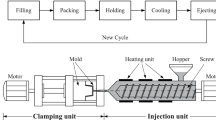Abstract
This study proposes an integrated optimization system to find out the optimal parameter settings of multi-input multi-output (MIMO) plastic injection molding (PIM) process. The system is divided into two stages. In the first stage, the Taguchi method and analysis of variance (ANOVA) are employed to perform the experimental work, calculate the signal-to-noise (S/N) ratio, and determine the initial process parameters. The back-propagation neural network (BPNN) is employed to construct an S/N ratio predictor and a quality predictor. The S/N ratio predictor and genetic algorithms (GA) are integrated to search for the first optimal parameter combination. The purpose of this stage is to reduce the process variance. In the second stage, the quality predictor is combined with particle swarm optimization (PSO) to find the final optimal parameters. The quality characteristics, product length and warpage, are dedicated to finding the optimal process parameters. After the numerical analysis, the optimal parameters can meet the lowest variance and the product quality requirements simultaneously. Experimental results show that the proposed optimization system can not only satisfy the quality specification but also improve stability of the PIM process.
Similar content being viewed by others
References
Lin TR (2003) Optimization technique for face milling stainless steel with multiple performance characteristics. Int J Adv Manuf Technol 19:330–335
Yang YK, Shi JR, Yang RT, Chang HA (2006) Optimization of injection molding process for contour distortions of polypropylene composite components via design of experiments method. J Reinf Plast Compos 25(15):1585–1599
Altan M (2010) Reducing shrinkage in injection moldings via the Taguchi ANOVA and neural network method. Mater Des 31:599–640
Fei NC, Kamaruddin S, Siddiquee AN, Khan ZA (2011) Experimental investigation on the recycled HDPE and optimization of injection moulding process parameters via Taguchi method. Int J Mech Mater Eng 6(1):81–91
Öktem H (2012) Optimum process conditions on shrinkage of an injected-molded part of DVD-ROM cover using Taguchi robust method. Int J Adv Manuf Technol 61:518–528
Mathivanan D, Parthasarathy NS (2009) Sink-mark minimization in injection molding through response surface regression modeling and genetic algorithms. Int J Adv Manuf Technol 45:867–874
Chen WC, Liu KP, Liu B, Lai TT (2013) Optimization of optical design for developing an LED lens module. Neural Comput Applic 22(3–4):811–823
Chen WC, Wang MW, Chen CT, Fu GL (2009) An integrated parameter optimization system for MISO plastic injection molding. Int J Adv Manuf Technol 44:501–511
Sun B, Wu Z, Gu B, Huang X (2010) Optimization of injection molding process parameters based on response surface methodology and genetic algorithm. In: Proc of the int’l conf. on Computer Engineering and Technology, pp 397–400
Zhai M, Xie Y (2010) A study of gate location optimization of plastic injection molding using sequential linear programming. Int J Adv Manuf Technol 49:97–103
Yang C, Huang HX, Caster JM, Yi AY (2011) Replication characterization in injection molding of microfeatures with high aspect ratio: influence of layout and shape factor. Polym Eng Sci 51(5):959–968
Chen WC, Tai YC, Wang MW, Tsai HC (2013) Parameter optimization of etching process for a LGP stamper. Neural Comput Applic 23(6):1539–1550
Chen WC, Tai PH, Wang MW, Deng WJ, Chen CT (2008) A neural network-based approach for a dynamic quality predictor in plastic injection molding process. Expert Syst Appl 35(3):843–849
Park HS, Dang XP (2010) Optimization of conformal cooling channels with array of baffles for plastic injection mold. Int J Precis Eng Manuf 11(6):879–890
Yin F, Mao H, Hua L, Guo W, Shu M (2011) Back-propagation neural network modeling for warpage prediction and optimization of plastic products during injection molding. Mater Des 32:1844–1850
Gandomi AH, Alavi AH (2012) A new multi-gene genetic programming approach to nonlinear system modeling, part I: materials and structural engineering problems. Neural Comput Applic 21(1):171–187
Xu G, Deng F, Xu Y (2011) Adaptive particle swarm optimization-based neural network in quality prediction for plastic injection molding. J Comput Inf Syst 7(2):462–470
Shi F, Lou ZL, Lu JG, Zhang YQ (2003) Optimization of plastic injection molding process with soft computing. Int J Adv Manuf Technol 21(9):656–661
Ozcelik B, Erzurumlu T (2005) Determination of effecting dimensional parameters on warpage of thin shell plastic parts using integrated response surface method and genetic algorithms. Int Commun Heat Mass 32(8):1085–1094
Kurtaran H, Erzurumlu T (2006) Efficient warpage optimization of thin shell plastic parts using response surface methodology and genetic algorithms. Int J Adv Manuf Technol 27(5–6):468–472
Zhao P, Zhou H, Li Y, Li D (2010) Process parameters optimization of injection molding using a fast strip analysis as a surrogate model. Int J Adv Manuf Technol 49:949–959
Chen WC, Kurniawan D, Fu GL (2012) Optimization of process parameters using DOE, RSM and GA in plastic injection molding. Adv Mater Res 472–475:1220–1223
Deng WJ, Chen CT, Sun CH, Chen WC, Chen CP (2008) An effective approach for process parameter optimization in injection molding of plastic housing components. Polym Plast Technol 47(9):910–919
Chen WC, Fu GL, Tai PH, Deng WJ (2009) Process parameter optimization for MIMO plastic injection molding via soft computing. Expert Syst Appl 36(2):1114–1122
Xu G, Yang Z, Long G (2012) Multi-objective optimization of MIMO plastic injection molding process conditions based on particle swarm optimization. Int J Adv Manuf Technol 58:521–531
Yang YK, Yang RT, Tzeng CJ (2012) Optimization of mechanical characteristics of short glass fiber and polytetrafluoroethylene reinforced polycarbonate composites using the neural network approach. Expert Syst Appl 39:3783–3792
Author information
Authors and Affiliations
Corresponding author
Rights and permissions
About this article
Cite this article
Chen, WC., Liou, PH. & Chou, SC. An integrated parameter optimization system for MIMO plastic injection molding using soft computing. Int J Adv Manuf Technol 73, 1465–1474 (2014). https://doi.org/10.1007/s00170-014-5941-1
Received:
Accepted:
Published:
Issue Date:
DOI: https://doi.org/10.1007/s00170-014-5941-1



